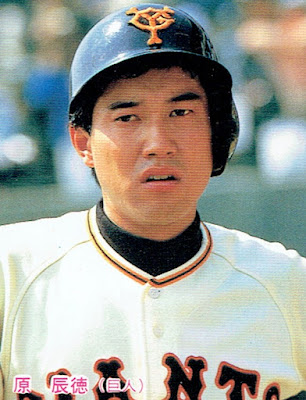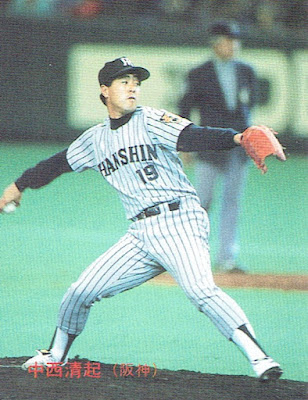1985
The 1985 set is significant for two reasons. The first is that for the first time Calbee included cards for the Lotte Orions. Because they were a rival snack company to Calbee, Lotte had not allowed Calbee to include their players in the card sets so with a few exceptions there are no Lotte players in the sets between 1973 and 1984. I don't know why Lotte relented in 1985 but they did so for the first time all 12 teams were represented in Calbee's card set.
The second significant thing about the 1985 set is that 100 of the cards have a drawing of the player on the back. Calbee had run a contest asking collectors (i.e. kids) to send in their drawings of their favorite players and the winning caricatures made the backs of cards 176 to 275. Calbee had run a similar contest in 1979 but I'm pretty confident there are many more contest winners in the 1985 set than in that set.
The set itself has 480 cards but is numbered to 465 - there are two different versions of cards 411 to 425. I'm not sure how many series the cards were issued in.
Most of the card backs were printed in pink ink - the exception being the cards with the caricatures. The backs of cards 1 to 50 have text that outlines how to submit drawings for the contest. Here's an example card of Tatsuo Komatsu:
The backs of cards 51 to 125 have the player's recent statistics. Here's a card of Hiromitsu Ochiai as an example (this is Ochiai's first ever Calbee card):
Cards 126 to 175 have comments about the players on their backs as this card of Hiromitsu Kadota shows:
As I mentioned above, cards 176 to 275 have the fan submitted drawings on their backs. The ink on these is mostly blue. Here's three example cards - Tatsunori Hara, Sachio Kinugasa and Masataka Nashida:
The backs of the remaining cards in the set have comments about the players again. Here's a card of Hiromichi Ishige to illustrate this:
1986
The 1986 Calbee set is probably the most straightforward Calbee set from their first 15 to 20 years. At 250 cards, it was the smallest set issued by Calbee in the 1980's. Again I'm not sure how many series the cards were issued in. The backs were printed with blue ink and there were two different types of backs. Cards 1 to 100 have the player's vital stats (birthdate, which way he bats and throws, blood type, etc). Here's a card of Koji Akiyama as an example:
The rest of the cards had comments about the players on their backs. Here's an example card of Leon Lee:
1987
1987 was pretty much more of the same. The set contained 382 cards and again I'm not sure how many series they were issued in. The backs had blue ink again (and would for the next few years).
The backs of the first 49 cards had bullets points with information about the player's career. Oddly enough though the back design had a minor change in those 49 cards as cards 26 to 49 had a horizontal line between the player's name and birthdate and the bullet points but the cards 1 to 25 don't have this line. Here's an example of each - Yoshio Mizukami is the card without the line and Kazuhiro Kiyohara is the card with the line:
Cards 326 to 382 have a gold border. Cards 326 to 375 have a little trophy on the front and celebrate the season's title holders. For example. this card of Hiromitsu Ochiai commemorates him leading the league in OBP:
The last seven cards in the set are very odd. They're all labeled something like "Rare Play" and appear to have a photo on them that was captured by taking a photo of a TV screen! They look terrible as this card of Carlos Ponce will attest:
1988
The 1988 set contained 331 cards but was numbered from 1 to 329 - card numbers 63 and 305 appear twice in the set. Once again I don't know how many series the set was issued in.
Once again the first cards in the set featured biographical bullet points about the player. The backs of cards 1 to 100 (with some exceptions I'll mention in a minute) included various pieces of information about the players including their salary and even their car. For example, this card of Kiyooki Nakanishi mentions that he makes 20 million yen and drives an "Audi 100 Turbo":
I mentioned that there were some exceptions in those first 100 cards (well, 101 since there were two different card 63s) - 1988 was the year the Tokyo Dome opened and there are seven cards (cards 19, 61, 62, one of the 63s, 64, 65 and 66) dedicated to the "Big Egg". Here's one of them:
Cards 101 to 115 appear to be very rare and commemorate the Opening Day games from 1988. I don't have any of these cards but it appears that they also feature photos that were taken of game action on TV.
Cards 116 to 304 have text about the player on their backs. Here's an example card for Yutaka Takagi:
You'll notice that the back of this card has "~No.239" in the lower right corner. I think this is an indicator of what the latest card in a series is. I'm not sure when they added this - the highest card number I have without it is 181. Cards 240 to 289 have "~No.289" on them and Cards 290 to 304 (which are all Dragons) have "~No.304" on them. This would imply that there was a 40 card series (cards 240 to 289) followed by a 15 card series (290-304).
One version of card 305 shows two photos of a play at the plate labeled something like "rain play". The card has borders at the top and bottom of it that look like a film strip. It also features a parallel number of "1" although there are no other cards with parallel numbers on them. The lower right corner of the cards has "~No.305" on it which implies that the card was its own series which seems very odd.
The rest of the cards in the set - starting with the OTHER version of card 305 and going to card 329 feature gold borders. These cards feature members of the pennant winning Dragons and Lions as well as title holders. The backs all have "~No.329" on them. I don't have any of these cards and like the "Opening Day" cards (101 to 115) they appear to be pretty rare.
1989
The 1989 set had a big change for Calbee but it didn't happen until after the first series. The set contained 414 cards and while I've got a bit of better idea of some of the card series, I'm still not sure how many there were that year. UPDATE - I somehow missed that Engel said the set was issued in five series.
I do know (or at least strongly suspect) that the first 110 cards were issued as one series. Why? Because all the cards had a "~No.110" on the backs. The backs of the cards showed the recent stats for the player as this card of Hiromi Makihara will attest:
The big change for Calbee happened after the first series - for the first time ever, the backs of the remaining cards in the set had the player's name in English. Larry Fuhrmann has claimed credit for convincing Calbee to use the English names but I have wondered if the fact that Lotte's set that year also had the names in English may have also been a factor.
Besides the player's name in English, the backs of the cards starting at card #111 have, once again, text about the player. It looks like cards 111 to 220 were issued as a single series and is apparently somewhat rare although I do have some cards from this series:
I'm a bit confused on the next series of cards - I'm not sure if it's 221 to 330 or 340. I have cards that have "~No.330" on them and ones that have "~No.340" on them. I suspect that the series is 221 to 340 but I don't know that for sure.
It looks like the remaining cards in the set were issued in two series - 341 to 390 and 391 to 414. Both series are rare with cards 391 to 414 being VERY rare - Engel's prices for these cards are between $100 to $300. I don't have any cards from either of those series.
Once again I heavily relied on the Calbee Collector's site for information along with Gary Engel's "Japanese Baseball Cards Checklist & Price Guide".








































1985 had some pretty amazing card backs.
ReplyDeleteGreat write up as always!
ReplyDeleteOne thing that really distinguishes these sets from each other, which might be worth mentioning, is the prevalence of short printed series in them.
The 1986 set is probably the easiest of the bunch to collect since it doesn't really have any short printed series in it (and its only got 250 cards in the whole set). The 1987 is also not too hard since it only has one short printed series (75 to 99 I think, all Giants players) which isn't too hard to find.
But the 1985, 1988 and 1989 all have significant blocks of short printed cards which are both hard to find and expensive, which makes them relatively harder to collect.